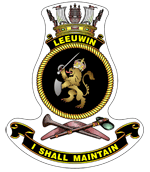HMAS Leeuwin (HS 01/A 245) is the lead ship of the Leeuwin-class of hydrographic survey vessels operated by the Royal Australian Navy (RAN).
 HMAS Leeuwin operating off Singapore in 2010
| |
| History | |
|---|---|
| Namesake | Cape Leeuwin |
| Ordered | 2 April 1996 |
| Builder | NQEA, Cairns |
| Launched | 19 July 1997 |
| Commissioned | 27 May 2000 |
| Homeport | HMAS Cairns, Cairns |
| Identification |
|
| Motto | I Shall Maintain |
| Status | Active as of 2019 |
| Badge |  |
| General characteristics | |
| Class and type | Leeuwin-class survey vessel |
| Displacement | 2,170 tons |
| Length | 71.2 m (234 ft) |
| Beam | 15.2 m (50 ft) |
| Draught | 4.3 m (14 ft) |
| Propulsion |
|
| Speed | 13 knots (24 km/h; 15 mph) |
| Range | 18,000 nautical miles (33,000 km; 21,000 mi) at 9 knots (17 km/h; 10 mph) |
| Complement | 10 officers, 46 sailors, up to 5 trainees |
| Sensors and processing systems |
|
| Armament | 2 × 12.7 mm machine guns |
| Aircraft carried | Not permanently embarked |
Design and construction
editLeeuwin has a displacement of 2,170 tons at full load.[1] She is 71.2 metres (234 ft) long, with a beam of 15.2 metres (50 ft), and a draught of 4.3 metres (14 ft).[1] Main propulsion machinery consists of four GEC Alsthom 6RK 215 diesel generators, which supply two Alsthom electric motors, each driving a propeller shaft.[1] A Schottel bow thruster is fitted for additional manoeuvrability.[1] Maximum speed is 13 knots (24 km/h; 15 mph), with a range of 18,000 nautical miles (33,000 km; 21,000 mi) at 9 knots (17 km/h; 10 mph).[1]
The sensor suite consists of a STN Atlas 9600 APRA I-band navigational radar, a C-Tech CMAS 36/39 hull-mounted sonar, an Atlas Fansweep-20 multibeam echo sounder, an Atlas Hydrographic Deso single-beam echo sounder, and a Klein 2000 towed sonar.[1] The sonars and echo sounders allow the vessels to chart waters up to 6,000 metres (20,000 ft) deep.[2] There are three sets of davits fitted to carry Fantome-class survey boats.[1] The ship is fitted with a helicopter deck, previously for an AS 350B Squirrel helicopter detached from 723 Squadron, although there are no long-term hosting facilities.[1] She is armed with two single 12.7 mm machine guns.[2] The ship's company consists of 10 officers and 46 sailors, plus up to 5 trainees.[1] The Leeuwin class were the first RAN ships to use a multi-crewing concept,[citation needed] with three complements used to operate the two vessels.[2]
Leeuwin was ordered from NQEA on 2 April 1996, and built at the company's shipyard in Cairns.[1] She was laid down on 9 May 1997 and launched on 23 June 1998.[2] Leeuwin and sister ship Melville underwent a joint commissioning ceremony on 27 May 2000.[1] Leeuwin initially carried the pennant number "HS 01", but this was changed to "A 245" in 2004.[2] She is named after Cape Leeuwin, the south-west-most point of the Australian continent.
Operational history
editIn late 2001, Leeuwin began to operate in support of border protection operations in addition to her normal hydrographic duties.[2][3] In January 2002, Leeuwin was repainted from white to grey.[2][3]
In October 2013, Leeuwin participated in the International Fleet Review 2013 in Sydney.[4] The fleet was reviewed by Governor-General Quentin Bryce on 5 October from Leeuwin's helicopter deck, with Bryce accompanied by Prince Harry.[5]
Leeuwin sailed to Fiji in July 2015 for a seabed-mapping operation around Rotuma Island.[6] This was the first RAN deployment to the region in eight years, since the deterioration of ties between the nations after the 2006 Fijian coup d'état.[6]
Citations
edit- ^ a b c d e f g h i j k Saunders (ed.), Jane's Fighting Ships 2008–2009, p. 33
- ^ a b c d e f g Wertheim (ed.), The Naval Institute Guide to Combat Fleets of the World, p. 26
- ^ a b Bateman et al., in Rothwell & VanderZwaag (eds.), Towards principled ocean governance, p. 130
- ^ "Participating Warships". International Fleet Review 2013 website. Royal Australian Navy. 2013. Archived from the original on 10 December 2013. Retrieved 14 December 2015.
- ^ Walsh, Fiona (4 October 2013). "International Fleet Review: seven to watch for when the ships come in". The Guardian. Retrieved 7 October 2013.
- ^ a b Talebula, Kate (14 July 2015). "Australian frigate on seabed survey mission". Fiji Times. Retrieved 19 July 2015.
References
edit- Bateman, Sam; Bergin, Anthony; Tsamenyi, Martin; Woolner, Derek (2006). "Integrated maritime enforcement and compliance in Australia". In Rothwell, Donald R.; VanderZwaag, David L. (eds.). Towards principled oceans governance: Australian and Canadian approaches and challenges. Oxon: Routledge. ISBN 978-0-415-38378-3.
- Saunders, Stephen, ed. (2008). Jane's Fighting Ships 2008–2009. Jane's Fighting Ships (111th ed.). Surrey: Janes Information Services. ISBN 9780710628459. OCLC 225431774.
- Wertheim, Eric, ed. (2007). The Naval Institute Guide to Combat Fleets of the World: Their Ships, Aircraft, and Systems (15th ed.). Annapolis, MD: Naval Institute Press. ISBN 9781591149552. OCLC 140283156.